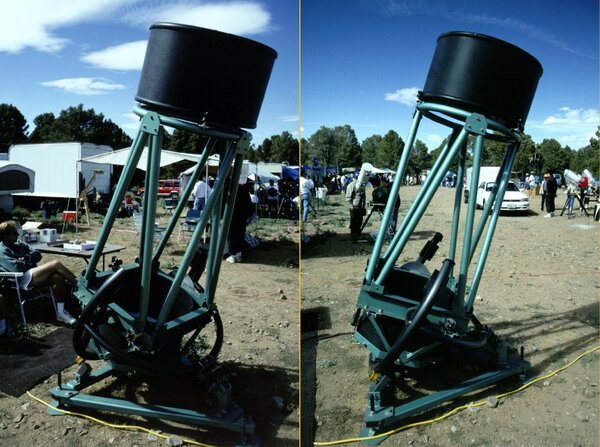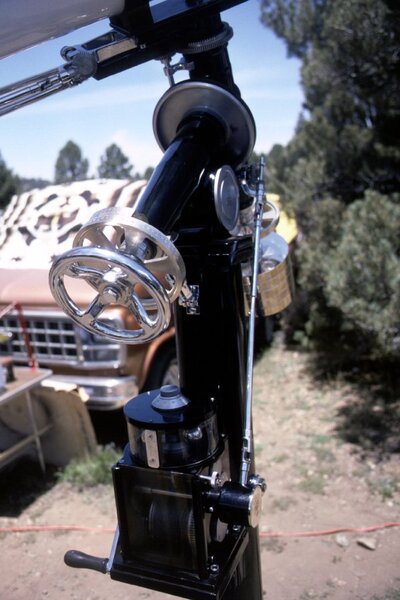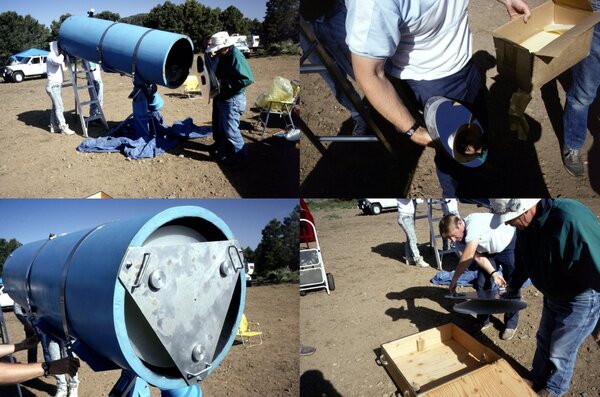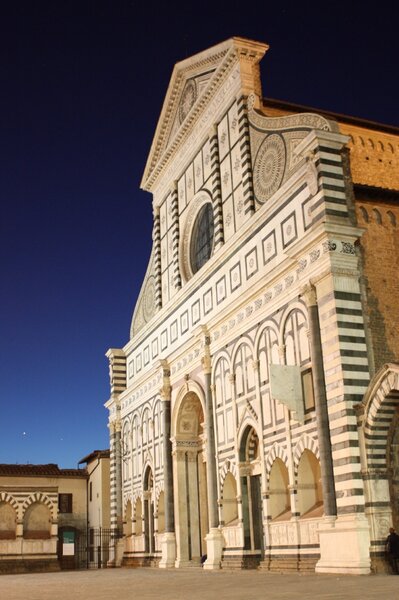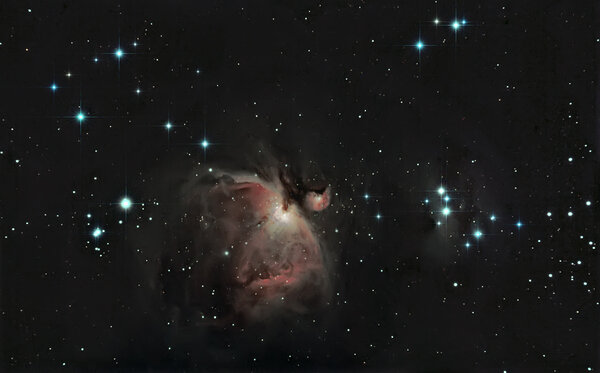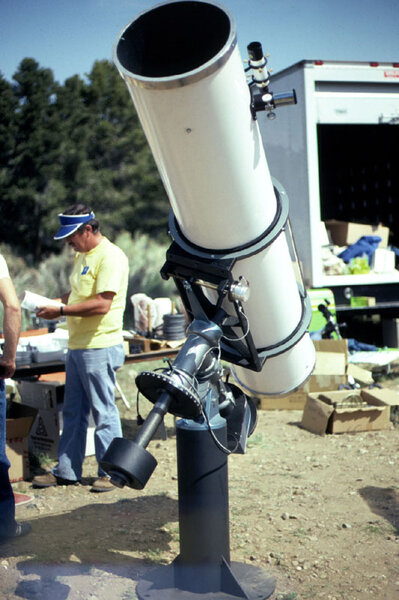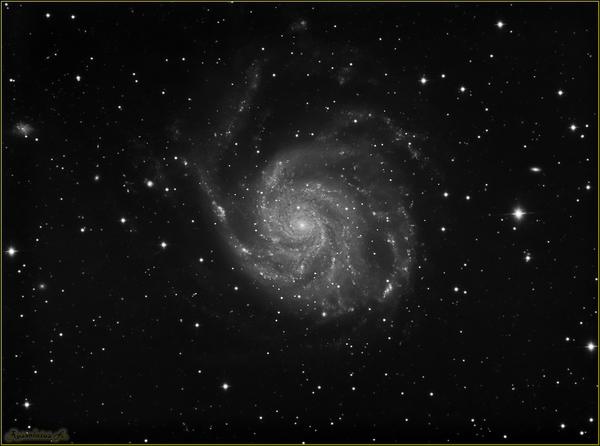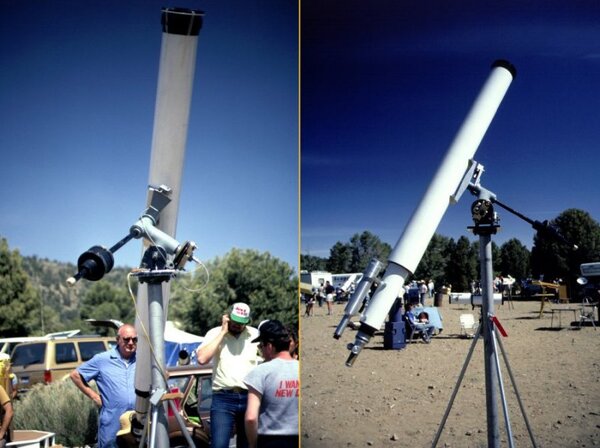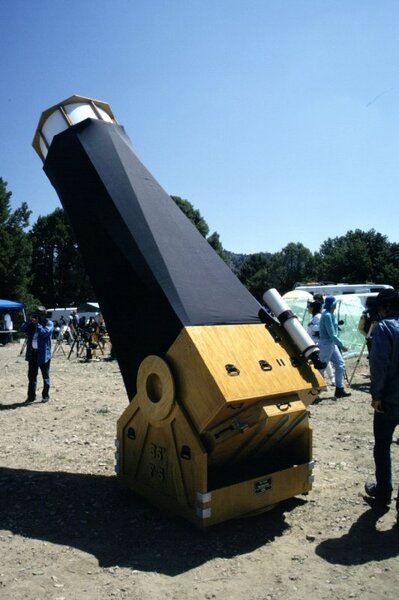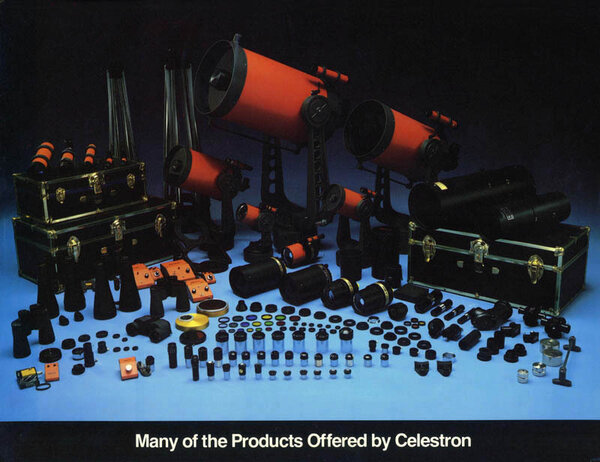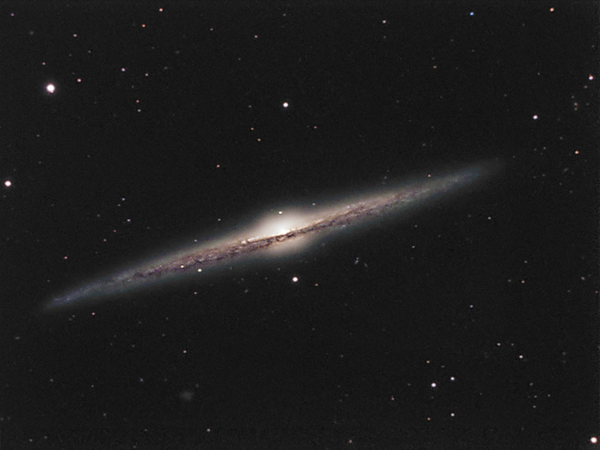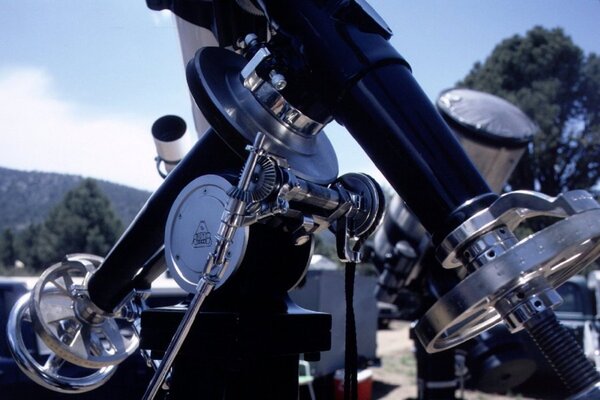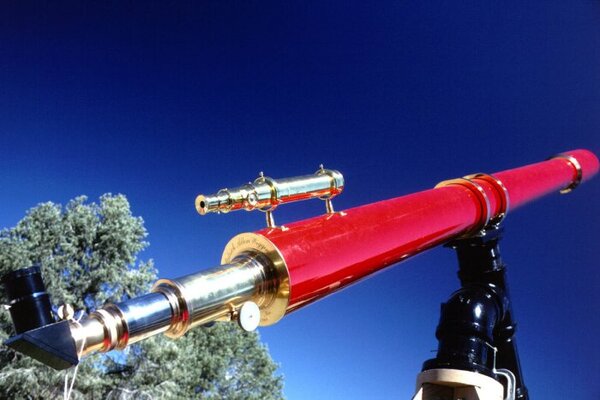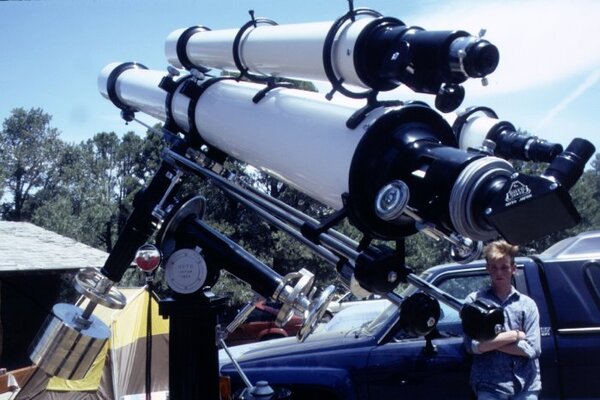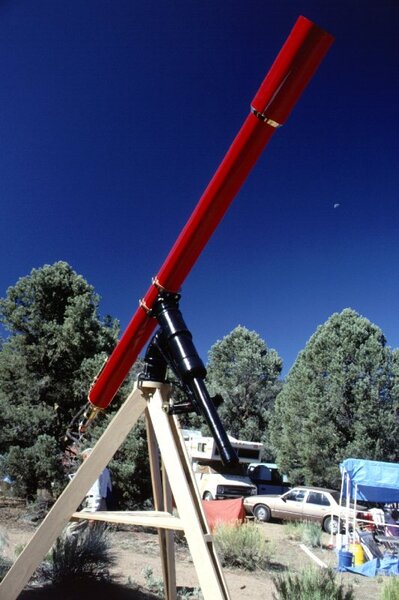-
Αναρτήσεις
1731 -
Εντάχθηκε
-
Τελευταία επίσκεψη
-
Ημέρες που κέρδισε
1
Τύπος περιεχομένου
Forum
Λήψεις
Ιστολόγια
Αστροημερολόγιο
Άρθρα
Αστροφωτογραφίες
Store
Αγγελίες
Όλα αναρτήθηκαν από Fred Ley
-
-

Goto 6" Refractor Clock Drive
Ο Fred Ley σχολίασε σε Fred Ley για αστροφωτογραφία Τηλεσκόπια και Εξοπλισμός
A weight drive can be used on other telescopes provided the neccessary modifications are made to accommodate the weight drive. There are individuals who have also made their own drives. It is rare these days when everyone uses electric drives. I always have had a strong nostalgic leaning towards this type of drive. This link will take you to a page on Cloudy Nights where you will see an old photo that I took of a home made weight drive. Just scroll down the page. http://www.cloudynights.com/ubbthreads/showflat.php/Cat/0/Number/3707895/page/0/view/collapsed/sb/5/o/all/fpart/4/vc/1 -Fred -
This 24-inch Newtonian has a conical mirror and a 6-inch secondary mirror. The secondary is shown in the owners hand and the conical shape of the primary mirror is viewable in the two views. The mirror rests in its case with the face of the mirror facing downwards. The mount is a Schaefer mount, built by Bill Shaefer of southern California.
-

Goto 6" Refractor Clock Drive
Ο Fred Ley σχολίασε σε Fred Ley για αστροφωτογραφία Τηλεσκόπια και Εξοπλισμός
-

ΒΟΗΘΕΙΑ ΜΕ CELESTRON CG5
Fred Ley απάντησε στην συζήτηση του/της dark nebula σε Στηρίξεις τηλεσκοπίων
I assume that you have set the index marks for both the RA and DEC axis to their correct position? When entering the time, one can select military time (2000 hours) or civil time 0800 p.m. If selecting civil time one has to indicate either AM or PM. It is possible that you may have simply overlooked a small step in the process, that can happen. The latest version of the manual for the CG5 mount can be found at this link http://www.celestron.com/c3/product.php?ProdID=92&CatID=16 Celestron has also listed an addendum to the manual in regards to the alignment procedure. Your answer may lie there. The two PDF files are located in the center of the page on your screen. Hope this helps. Keep us posted, you should be able to solve this and start racing across the heavens with your telescope-at warp speed! -Fred -

αστροστατης και ταχυτητες.πλανητικη παρατηρηση?λιγη βοηθεια.
Fred Ley απάντησε στην συζήτηση του/της Εύβοιαν έχω,κόσμον έχω... σε Φωτογράφηση ηλιακού συστήματος
Hello, Celestron has an online manual that one can downoad for the CG4 equatorial mount. From what I see the clock drive for the mount should be at the siderial rate. The planetary and lunar rates are slightly different, but, as Adams has pointed out, they should not interfere with your ability to take images. The manual also has a section dealing with introductory astrophotography. The manual can be located at http://www.celestron.com/c3/product.php?ProdID=433 In the middle of the page is the link for the manual which is 9.2MB in size. The manual also informs the user as to how to go about polar aligning the mount. Hope that this is of some help to you. Waiting to see your first results. -Fred -

Η Αφροδιτη και ο Ερμης εδωσαν ραντεβου...
Ο Fred Ley σχολίασε σε Kalbie για αστροφωτογραφία Πλανητικές Συναντήσεις και Σύνοδοι
-
-
Spyros, The PARKS 12.5-inch reflector shown here has a PARKS fiberglass tube that is 15-7/8-inches ID. That is 15.875-inches inside diameter. The mirror is 12.5-inches in diameter. So, naturally, there is a 3.375-inches (3-3/8-inch difference. The clearance around the mirror comes out to be 1.6875-inches or 1-3/16-inches clearance between the mirror and the tube. As to issues with thermal currents, the embraces a few diferent things. One of course is the thickness of the mirror, another is the cooldown time bwtween the mirror and the outside atmosphere and how quickly the temperature changes. I am certain that you are aware that many people have placed fans behind their mirror mount in order to help with the image quality. I have an article that states that all of the turbulence is relegated to the few inches directly above the face of the mirror and that a fan should be placed perpendicular to the actual surface of the mirror. Therefore drawing the warm curents across and away from the surface of the mirror in a more direct fashion. Placing a fan behind the mirror will of course draw air around the sides o fthe mirror, but it will move the air less as one moves away form the edge of the mirror towards the center of the mirror. Naturally for planetary and lunar observing one wants the best seeing possible. For those really extended objects like clusters, nebula and galaxies, practically any seeing condition is ok-as far as I am concerned. Angelos, You are correct, the Riverside Telescope Makers Conference is a great place for the amateur telescope maker to show the fruit of his or her labor. There are awards given out for workmanship. At nightfall the telescopes are all trained on objects in the night sky. A few people will actually do some cdd, comet searching or whatever else interests them. Years ago a member from the San Jose Astronomical association, Dom Machholz, discovered a comet at the event and a marker was placed at the spot where his telescope was set up. There is also the talks that take place from themornig up to the evening with breaks for lunch and dinner. During the day it is a "feeding frenzy". On Saturday morning there is the swap meet where people bring all the things that they want to sell and it gets real crazy. Picture 500 pounds of steak being thrown overboard into shark infested waters.
-
-
-

Observing Variables 1979
Fred Ley δημοσίευσε μία αστροφωτογραφία σε Διάφορες αστρονομικές φωτογραφίες
Observing variable stars for the American Association of Variable Star Observes (AAVSO) in Aghia Paraskevi, Attiki. August 1979. From lef tto right- Frederick N. Ley, George Stephanopoulos and George Mavrofridis. Telescopes are a 4-inch and 2.4-inch Polarex refractors. George S. has been observing variable stars since 1969 and George M. has been observing variables since 1979. Both of them have done a commendable job. -
I must assume that you have already visited Stellafane's web site, if not, it warrants a visit. It is at http://stellafane.org/ You will find a plethora of inofrmation on making telescopes, suppliers, lot of images of ATM telescopes and toms of additional inofrmation. Be prepared to spend some time going through the site. I have the biography of Russell W. Porter by Berton C. Willard and it makes very interesting reading. The history of astronomy is one of my main interest too. Do try to find time to go through the Stellafane site, if you have not already done so, it is very interesting. Fred
-
-

Φωτογραφία από την τρίτη φάση του διαγωνισμού
Ο Fred Ley σχολίασε σε Tsaprazi για αστροφωτογραφία Αστρονομικές δραστηριότητες
-
-
-

Φωτογραφία από την τρίτη φάση του διαγωνισμού
Ο Fred Ley σχολίασε σε Tsaprazi για αστροφωτογραφία Αστρονομικές δραστηριότητες
-

Goto 6" German Equatorial Mount
Ο Fred Ley σχολίασε σε Fred Ley για αστροφωτογραφία Τηλεσκόπια και Εξοπλισμός
-
-
Hi Ourania, The telescopes shown here on Astrovox are from the Riverside Telescope Makers Conference, held every May at Big Bear Lake in Southern California at an altitude of about 7,500 feet. Some telescopes and a list of the talks given at past events, along with awards for home made telescopes can be found at the following web site http://www.rtmcastronomyexpo.org/ if interested. I have never made it to Stellafane in Vermont, which is clear on the other side of the country. California is a nice place to visit for such an event. Apart from the RTMC event there is JPL in Pasadena, Mt. Wilson Observatory (60-inch and 100-inch), Mt Palomar Observatory, Big Bear Solar Observatory, Griffith Observatory and planetarium in Los Angeles. Astronomy clubs in the Southern California area always have events going on on the weekends. So if one were to visit an RTMC event and wanted to some more astronomy oriented sightseeing, there is lots. There is also the telescope manufacturers in the area, but I do not think that they offer tours of their facilities. Apart from the world of astronomy, there is sports, the coast, and a whole host of other things to see and do. There is always Disneyland. -Fred
-

Goto 6" German Equatorial Mount
Fred Ley δημοσίευσε μία αστροφωτογραφία σε Τηλεσκόπια και Εξοπλισμός
-
Here is the weight driven clock drive that moves the telescope in RA. To the left of the drive is the handle that is turned to wind up the drum the has the cable wound around it. The drum and cable are visible through the window of the drive. The weight at the end of the cable is suspended inside the pier.
-
-


